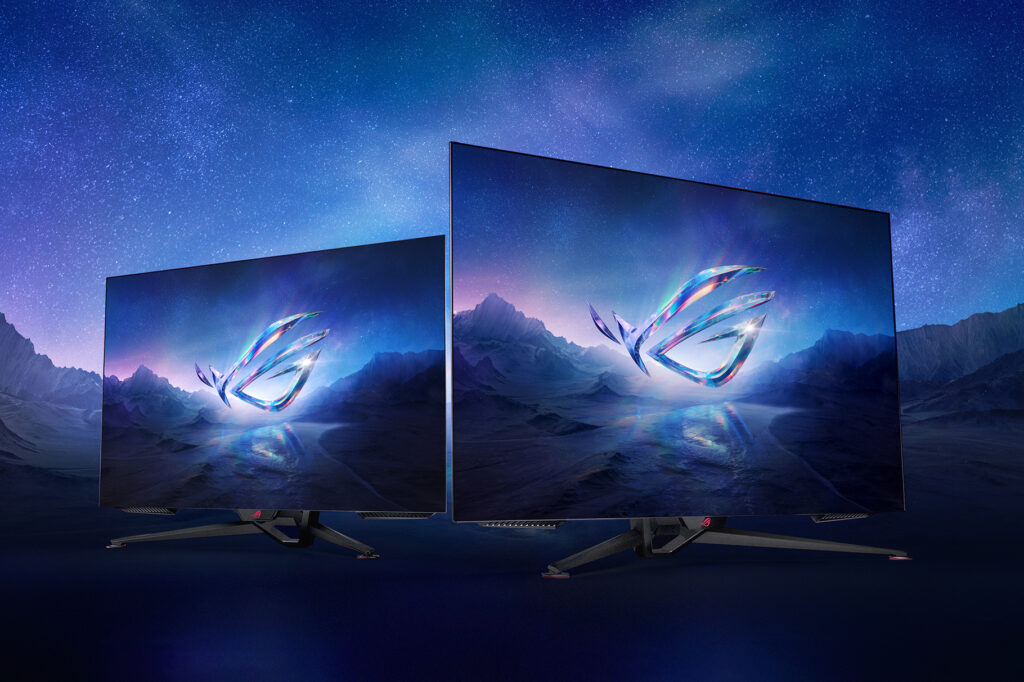LG OLED TV C2/C3 vs ASUS OLED PG42UQ for Gaming Review

Last updated on July 14, 2023
Today we are comparing two OLED displays that are popular among gamers: the ASUS PG42UQ monitor and the LG C2/C3 OLED TV. Both of these displays are 42 inches in size and have 4K resolution, but which one is better for gaming? Let’s find out!
To make this comparison fair and easy, we are going to list the pros and cons of each display based on personal experiences and some online research. Here we go:
Table of Contents

ASUS PG42UQ Pros:
- It has a 138Hz refresh rate (overclocked) which is higher than the LG C2/C3’s 120Hz refresh rate. This means smoother gameplay and less motion blur.
The PG42UQ response times are a mind blowing 0.1ms. This is 10x faster than any other OLED panel out there.Real world test place both the PG42UQ and the LG C2 at an average 1ms.- It has a DisplayPort input which allows you to connect it to your PC and use DSC (Display Stream Compression) to achieve 4K 138Hz with HDR and adaptive sync. This is a feature that the LG C2 doesn’t have.
- It has a matte anti-glare coating on its screen which reduces mirror-like reflections and makes it easier to see in bright environments.
- It has a USB 3.2 hub and a tripod socket which are useful for connecting peripherals and accessories like a webcam or a microphone.
- It has excellent audio quality from its internal speakers which include a subwoofer for extra bass.
ASUS PG42UQ Cons:
- It is expensive. It costs around $1400 which is the same as the LG C2/C3’s MSRP, but the LG C2/C3 often goes on sale for lower prices.
- It has high input lag with 60Hz signals which can affect your gaming performance if you’re playing games that are locked at 60Hz or lower. This is especially noticeable for console gamers who use HDMI inputs.
- It doesn’t support HLG (Hybrid Log Gamma) and Dolby Vision which are advanced HDR formats that can deliver better picture quality than HDR10 in some cases. However, not all games support these formats anyway.

LG C2/C3 Pros:
- It has a glossy anti-reflective coating on its screen which makes colors pop and increases the clarity and crispness of the image. It also provides deeper apparent blacks as diffuse reflections are minimized.
- It has a smart system that allows you to access various streaming apps and services like Netflix, YouTube, Disney+, etc. It also has image processing features like motion interpolation and noise reduction that can enhance the picture quality of lower-resolution content.
- It supports HLG (Hybrid Log Gamma) and Dolby Vision in addition to HDR10. These are advanced HDR formats that can deliver better picture quality than HDR10 in some cases.
- It has four HDMI 2.1 ports which allow you to connect multiple devices and take advantage of their full potential. You can play games at 4K 120Hz with HDR on this TV with both PC and console.
LG C2/C3 Cons:
- It has some mirror-like reflections that can be distracting in bright environments. If you have light sources in front of the display or just a bright room in general, you might notice clearly defined reflections visible on screen.
- It doesn’t have a DisplayPort input which means you can’t use DSC (Display Stream Compression) to achieve 4K 138Hz with HDR and adaptive sync. You’re limited to 4K 120Hz with HDMI inputs.
- It doesn’t have a USB 3.2 hub or a tripod socket which means you’ll need extra cables and adapters to connect peripherals and accessories like a webcam or a microphone.
Multi-Monitor HDR Gaming
If you want to enjoy the ultimate gaming experience with multi-monitors, you need to pay attention to the ports on your GPU and monitors. For Nvidia Surround or AMD Eyefinity, you need at least two HDMI ports or DisplayPorts that are similar. But not all GPUs have two HDMI ports, some only have one. And if you want to go for a triple screen HDR setup, you will definitely need three DisplayPort connections.
That’s why LG C2/C3 are not suitable for this kind of setup, because they don’t have any DisplayPort connections. You won’t be able to play in HDR with three monitors using these models. Some GPUs might allow you to play in HDR with two monitors (2 HDMI 2.1 Ports), but they are rare. PG42UQ is a better choice for HDR gaming, because it has DisplayPort connections, and it can handle three monitors without any issue.
Firmware Issues with PG42UQs
Since the release of the PG42UQ in late October 2022, they have been plagued with firmware issues. While most of the issues have been resolved with the latest V033 firmware, users are still experiencing incorrect color and color saturation issues with HDR enabled. Luckily our team has been able to help these users with their settings using this guide, but it is still a point to consider when deciding which monitor to purchase.
We should note, a PG42UQ owner who recently purchased their monitor reported no issues with the HDR and, also informed us his monitor was running on firmware version V035. However, during the writing of this article ASUS still has not resolved the HDR issue for customers and, the firmware V035 has still yet to be seen as a download option on ASUS’s website. Customers have been waiting 8 long months with only rumblings of a new firmware release. Needless to say, we are not holding our breath.
Conclusion
So, which display is better for gaming? Well, it depends on your preferences and your setup. If you’re a PC gamer who wants the highest refresh rate and response times possible for a 4K monitor, then the ASUS PG42UQ might be the better choice for you. If you’re a console gamer who wants more built-in features, then the LG C2/C3 OLED TV might be the better choice for you. If you are a multi-monitor HDR gamer, your clear choice is the PG42UQ.
Read More: ASUS PG42UQ OLED HDR Best Settings Guide






Responses